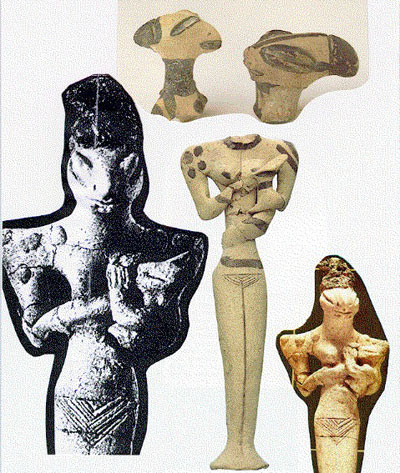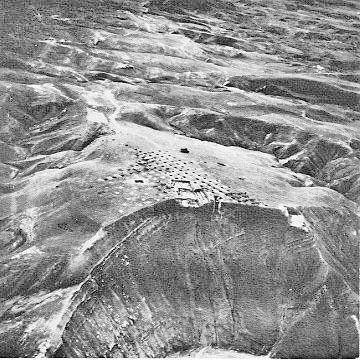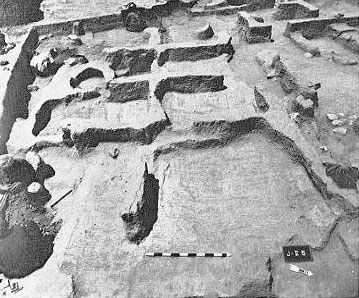|
The Jarmo
"Connection"
In the Bible... after the deception,
God says that from then on, the
serpent would have no legs and crawl around on his belly? Doesnít
this imply that at the time the serpent DID have legs... kind of like
a reptoid?
Genesis 3:15
"And I will put enmity between thee and the woman, and
between thy seed and her seed; it shall bruise they head, and thou shalt bruise his heel."
Is there a race of reptoids co-existing with us? Is there a secret
group, running the world who worship a reptoid? Is it just one of
MANY reptoids? Is it the leader of the reptoids? Is it a completely
different being, separate from those reptoids? Do those reptoids
even exist? Are the reptoid race nothing more than Mankindís
perceived evils personified into a form which is the personification
of evil in the Bible? Is it the Bible which makes them Reptoid and
not, say.. arachnid?
So would Eden be real? Not in the literal sense, but an actual place
that man was banished from because of these reptoids?
It is said that the garden of Eden was not on this planet and that
we have been planted and the reptoid were our jailers?
On the subject of Reptoids and such, are any of you familiar with
the statuettes from the
Jarmo excavation? Reptilian people doing
ordinary things, nursing babies, etc.... and they also made them of
regular people, so, combined with the ordinary activities they are
depicted doing, not likely to be idols or anything of the sort....
Itís 7000 BC actually, and in Iraq.... so probably largely destroyed
by now.
The stories about reptilian visitors extend from India, to Mexico,
to China, back to North America, and Russia, and even many parts of
Africa and South America.
There are a lot of links to Jarmo and these lizard people and many
other early cultures of the with similar traditions. The Jarmo
statuettes are the closest thing to hard evidence. It goes without
saying, in a world full of skeptics, any bits of hard evidence are
priceless.
David Ickeís
Biggest Secret book has a photo of this statue... This
one is also from Iraq, but from
the Ubaid area. It appears to be a
reptilian suckling one of its offspring. The Ubaid period was from
5500 - 4000 B.C.
A reptile statue found in graves of the Ubaid people who lived in
what is now Iraq up to around 4,000 BC. This culture predates the
Venus cataclysm which probably forced the surviving reptilians
underground or into another dimension.

As for Pindar, Icke translates the name as meaning
Penis of the
dragon and states that Pindar is also known as the Marquis of Libeaux. At the time he was writing the book,
Icke had little else
to say about this particular reptilian other than stating that he is
above the Windsors in the Brotherhood hierarchy.
Jarmo
Jarmo is an archeological site located in northern Iraq on the
foothills of the Zagros Mountains. For a long time it was known as
the oldest known agricultural community in the world, dating back to
7000 BC. It is also one of the oldest Neolithic village sites to be
excavated. It was first found in 1940ís by the Iraqi Directorate of
Antiquities, which later recommended the site to Robert Braidwood of
the Oriental Institute of the University of Chicago. He had been
asking about ancient villages in the Middle East for a study he was
conducting. Under the Oriental Institute, Braidwood excavated the
site at different times from March 1948 until June of 1955. He
wanted to find out more about the origin of food production. The Jarmo archeological site was one of the first means of documentation
for the way of life of civilizationís first farmers and herders.

There were approximately 100 to 150 people who lived in the village.
Twenty permanent mud-walled houses, with stone foundations, tuff
walls, and reed bedding, housed the residents of Jarmo. The people
reaped their grain with stone sickles, stored their food in stone
bowls, and possessed domesticated goats, sheep, and dogs. They also
grew emmer and einkorn wheat, barley, and lentils. In addition to
their agriculture, they also foraged for wild plants such as the
field pea, acorns, pistachio nuts, and wild wheat. The later levels
of settlement contained evidence of domesticated pigs and clay
pottery. Since many of their tools were made of obsidian from beds
300 miles away, a primitive form of commerce must have existed. Bone
tools, especially awls, were abundant from the site. Carefully made
bone spoons and beads were also found.

Braidwood said, after he was unable to excavate the site any further
due to political reasons, that Jarmo as a settlement was an social
and economical example for future Mesopotamian cultures that would
arise around 4000 BC. It was also the first site in the Near East in
which interdisciplinary field archeology was used to discover the
origins of food production.
References:
|


